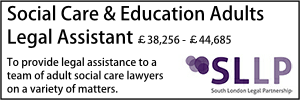Giant leaps or gentle steps?
- Details
 Kevin Jaquiss examines some of the key issues around mutualisation in the NHS.
Kevin Jaquiss examines some of the key issues around mutualisation in the NHS.
In the charge towards delivering transformation across the NHS, the concept of mutualisation has attracted support over recent years. There are many examples of social enterprises operating outside the NHS, but providing publicly-funded health services. According to Cabinet Office figures there are currently 53 mutual organisations providing some form of service to the NHS.
At the heart of this movement is the view that mutuals and social enterprises facilitate more effective staff engagement and involvement, the result of which will be service improvements. On the back of the recent King’s Fund investigation into the engagement of NHS staff led by Chris Ham, the Government has established a Pathfinder Programme. The programme is designed to help trusts consider the potential advantages of the mutual model and what it would mean for them, leaving them to evaluate the option and decide on potential models, with the Cabinet Office providing funding to support this evaluation process.
Defining mutual
The Cabinet Office’s definition of a mutual is broad, extending to structures such as charities, social enterprises, community interest companies, partnerships, and joint ventures. The scheme is working with providers interested in exploring "whole organisational change".
Any NHS Trust or Foundation Trust (FT) wishing to adapt itself wholesale to fall within one of the options would face a number of significant challenges, not least among which would be the need for legislative changes to accommodate a complete structural alteration. The need for transformational change is, however, immediate.
Steps to transformation without structural change for clinical and non-clinical services
It is possible to consider taking steps which are aimed at delivering transformation which do not involve the "big bang" approach currently envisioned by government.
Although this is a complex issue with a number of influencing factors, it may help to sketch out a number of possibilities, particularly for FTs, at a high level.
In our thinking, we have drawn a distinction between clinical services and non-clinical support services. We have done this because of:
- the obvious sensitivities around clinical activity;
- the simpler legal position in terms of structuring support services.
Both of these factors translate into an opportunity to develop a more complete or radical solution in respect of support services, whereas a more gradual approach may be advisable in a clinical context.
Possible steps for non-clinical or support services
FTs have considerable flexibility as a result of their commercial powers in terms of the formation and ownership of an entity independent of the trust. It is possible for an FT to form a subsidiary entity and to transfer some of its support activities into that entity. That entity could take a number of forms (e.g. a company limited by shares or guarantee, a limited liability partnership etc.) and could be owned solely by the trust or jointly by the trust with others (e.g. a commercial partner and/or the trust’s employees). Subject to its constitution and any agreements between the shareholders, it could also be a transferable asset.
Depending on prevailing procurement requirements, the entity could also provide services to the trust as well as third parties, thereby generating revenue as well as enhancing capital value. This approach has already been adopted by a number of FTs.
In employment terms, there would be a TUPE transfer of all the trust’s staff involved in providing the services in question; this would not usually be a significant issue in practice.
Monitor’s requirements from a compliance point of view would have to be factored into the flow of the transaction under which the new body was created.
The structure would be underpinned by objectives, use of profit, share ownership, asset protection and governance provisions which would reflect general principles of social enterprise.
Possible steps for clinical services
FTs are already forms of social enterprise – they operate for a community benefit purpose and offer an ownership stake to their local populations and to their staff. The emphasis to date has been on accountability to the local population through this structure. The Government’s approach is much more attuned to the benefits of staff engagement. Any organisation-wide change in emphasis which results in increased influence for staff will require additional powers to be provided to FTs.
There are also currently issues around the legal powers of NHS Foundation Trusts seeking to move individual clinical units or service lines into the type of structure previously outlined for support services. Given the obvious sensitivities around the provision of clinical services and the sheer scale of the operations of most FT trusts, it would seem unwise to adopt a "big bang" approach until a demonstrably successful model has been developed.
With all this in mind, a more gradual approach (which could be described as "mutual-lite" or as a "virtual mutual") could be adopted which would allow a FT to identify an appropriate and scalable service unit which would be used as a pilot. The pilot would be used to test the benefits of adopting certain changes to current practices reflecting the characteristics of mutual structures - offering employees involvement in decision-making and wider governance and establishing incentive-based pay structures. If it is established that the benefits can be delivered, a number of options can be considered for structural change can be considered, including a “big bang” tranformation to a staff or multi-stakeholder mutual.
A further benefit of this approach is that it creates a staff group who understand the proposed changes and may be willing to act as ambassadors for them. The sense that “mutualisation” is something done to staff by their employer has been an inhibiting factor in this area of public sector reform for a number of years.
Kevin Jaquiss is a partner at business law firm DWF. He can be contacted on 0845165 5494 or






























